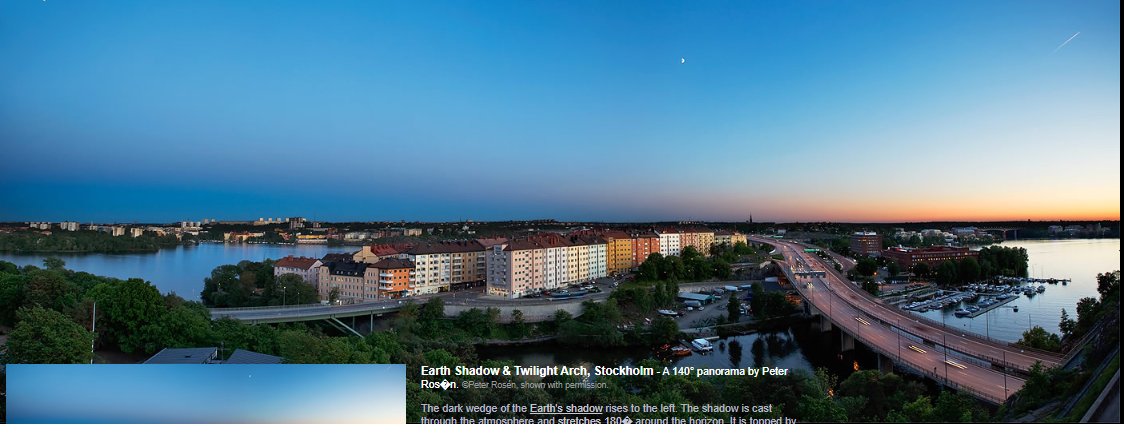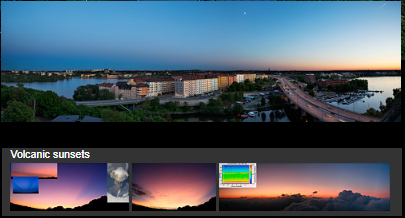Earth Shadow & Twilight Arch Stockholm
Earth Shadow & Twilight Arch Stockholm: A Phenomenon of Atmospheric Optics
Atmospheric optics never fails to mesmerize us with its captivating displays. One such captivating phenomenon is the Earth Shadow and Twilight Arch, which can be observed in Stockholm and various other locations around the world. This awe-inspiring display occurs during twilight, when the sun is below the horizon but still illuminates the atmosphere, creating a stunning interplay of colors and shadows.
The Earth Shadow, also known as the "dark wedge," is a prominent feature of this phenomenon. It rises to the left and stretches an impressive 180 degrees around the horizon. This shadow is cast through the Earth's atmosphere, giving it a distinct shape and depth. As the sun sets, its rays pass through a thicker layer of the atmosphere, causing shorter wavelengths to scatter more and longer wavelengths, such as red and orange, to dominate. This scattering effect results in the Earth Shadow appearing darker and redder as it reaches higher into the sky.
Topping the Earth Shadow is a beautiful pink glow known as the "anti-twilight arch" or the "Belt of Venus." This ethereal band of light is caused by scattered and deeply reddened sunlight on the edge of the Earth Shadow. The atmospheric particles scatter the sunlight, creating a mesmerizing blend of pink and purple hues against the deep blue eastern sky. The colors of the anti-twilight arch can vary depending on atmospheric conditions and the amount of dust or pollutants present in the air.
On the opposite side of the horizon, towards the west, lies the "twilight arch." This narrow band of reds and yellows lines the western horizon. Unlike the Earth Shadow, which appears darker, the twilight arch is still illuminated by the sun. The sun's rays pass through a thicker atmospheric path near the horizon, causing further scattering of light. This scattering effect, known as Rayleigh scattering, causes shorter wavelengths to scatter more, resulting in the reddening of the sun's rays. As a result, the twilight arch showcases a vibrant display of red and yellow hues.
What makes the Earth Shadow and Twilight Arch even more fascinating is their ever-changing nature. As the sun continues to descend below the horizon, the brightness and colors of the twilight arch transform from minute to minute. This dynamic interplay of hues creates a captivating spectacle for observers. Even on days without volcanic activity, which can enhance the colors of twilight, ordinary twilights can still surprise us with their beauty and variety.
The Earth Shadow and Twilight Arch phenomenon is not limited to Stockholm; it can be observed in various locations worldwide. However, the specific atmospheric conditions, including the presence of dust particles, pollutants, and the geographical features of each location, contribute to unique variations in this stunning display. No two Earth Shadow and Twilight Arch spectacles are exactly alike, making each observation a truly special experience.
In conclusion, the Earth Shadow and Twilight Arch in Stockholm offer a breathtaking display of atmospheric optics. The interplay of colors, shadows, and atmospheric phenomena creates an enchanting scene that captivates both casual observers and seasoned photographers alike. The ever-changing nature of this phenomenon ensures that each observation is a unique and awe-inspiring experience. So, next time you find yourself in Stockholm during twilight hours, be sure to look towards the horizon and witness the mesmerizing dance of light and shadow in the Earth Shadow and Twilight Arch.


Earth Shadow & Twilight Arch, Stockholm - A 140° panorama by Peter Ros�n. ©Peter Rosén, shown with permission.
The dark wedge of the Earth's shadow rises to the left. The shadow is cast through the atmosphere and stretches 180� around the horizon. It is topped by the pink glow of the 'anti-twilight arch', also called the 'Belt of Venus'. There the air is lit by scattered and deeply reddened sunlight on the shadow's edge. It mingles with the deep blues of the eastern sky to form the pink/purple hues.
To the right the western horizon is lined with a narrow band of reds and yellows, the 'twilight arch'. The westward atmosphere is still sunlit and near the horizon where the atmospheric path is thickest the sun's rays are reddened by Rayleigh scattering then further scattered to our eyes.
The twilight arch's brightness and colours change as the sun gets further below the horizon. The twilight hues and shades alter from minute to minute. We have seen many volcanic twilights recently - 'ordinary' ones have their moments too!
Note: this article has been automatically converted from the old site and may not appear as intended. You can find the original article here.
Reference Atmospheric Optics
If you use any of the definitions, information, or data presented on Atmospheric Optics, please copy the link or reference below to properly credit us as the reference source. Thank you!
-
<a href="https://atoptics.co.uk/blog/earth-shadow-twilight-arch-stockholm/">Earth Shadow & Twilight Arch Stockholm</a>
-
"Earth Shadow & Twilight Arch Stockholm". Atmospheric Optics. Accessed on November 26, 2024. https://atoptics.co.uk/blog/earth-shadow-twilight-arch-stockholm/.
-
"Earth Shadow & Twilight Arch Stockholm". Atmospheric Optics, https://atoptics.co.uk/blog/earth-shadow-twilight-arch-stockholm/. Accessed 26 November, 2024
-
Earth Shadow & Twilight Arch Stockholm. Atmospheric Optics. Retrieved from https://atoptics.co.uk/blog/earth-shadow-twilight-arch-stockholm/.